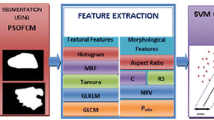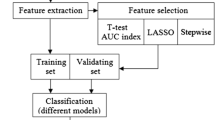Abstract
Papillary breast lesions include a wide spectrum of pathologies ranging from benign to malignant. The word papillary originates from finger-like projections, or papules, which are seen when these lesions are projected under a microscope. Papillary breast lesions have an array of radiological features at presentations; hence differentiation between benign and malignant based on imaging features is challenging. Histopathological diagnosis is crucial for the distinction and further management of the lesions. Traditionally, tumor and ductal excision is the treatment of choice for malignant and atypical or benign papilloma with imaging discordance. However, current clinical practice guidance advocates complete surgical excision, even for asymptomatic and purely benign papillomas diagnosed on core needle biopsy, as they are highly associated with atypia and malignant upstage on subsequent surgery. Computer aided diagnosis (CAD) is a non-invasive method of diagnosing medical signals/images using advanced image processing followed by soft computing techniques. In this study, we have developed a non-invasive CAD system for differentiating benign versus malignant papillary breast lesions using bi-dimensional empirical mode decomposition (BEMD) and the discrete cosine transform (DCT) followed by locality sensitive discriminant analysis (LSDA). The developed model is validated using a large collection of ultrasound images of papillary breast lesions, and achieved a maximum performance of 98.63% accuracy. We have also developed a breast papillary index, which may in the future be used as a substitute for the conventional soft computing techniques. The developed model can be utilized as a tool to assist radiologists in their routine clinical practice after validation with a larger database.







Similar content being viewed by others
References
Acharya UR, Faust O, Sree SV, Molinari F, Suri JS (2012a) ThyroScreen system: high resolution ultrasound thyroid image characterization into benign and malignant classes using novel combination of texture and discrete wavelet transform. Comput Methods Programs Biomed 107(2):233–241
Acharya UR, Ng EY-K, Tan J-H, Sree SV, Ng K-H (2012b) An integrated index for the identification of diabetic retinopathy stages using texture parameters. J Med Syst 36(3):2011–2020
Acharya UR, Faust O, Sree SV, Ghista DN, Dua S, Joseph P, Ahamed VT, Janarthanan N, Tamura T (2013) An integrated diabetic index using heart rate variability signal features for diagnosis of diabetes. Comput Methods Biomech Biomed Eng 16(2):222–234
Acharya UR, Fujita H, Sudarshan VK, Mookiah MRK, Koh JE, Tan JH, Hagiwara Y, Chua CK, Junnarkar SP, Vijayananthan A, Ng KH (2015a) An integrated index for identification of fatty liver disease using radon transform and discrete cosine transform features in ultrasound images. Inf Fusion 31:43–53
Acharya UR, Fujita H, Sudarshan VK, Sree VS, Eugene LWJ, Ghista DN, San Tan R (2015b) An integrated index for detection of sudden cardiac death using discrete wavelet transform and nonlinear features. Knowl-Based Syst 83:149–158
Acharya UR, Raghavendra U, Fujita H, Hagiwara Y, Koh JEW, Hong TJ, Sudarshan VK, Vijayananthan A, Yeong CH, Gudigar A, Ng KH (2016) Automated characterization of fatty liver disease and cirrhosis using curvelet transform and entropy features extracted from ultrasound images. Comput Biol Med 79:250–258
Acharya UR, Mookiah MRK, Koh JEW, Tan JH, Bhandary SV, Krishna Rao A, Hagiwara Y, Chua CK, Laude A (2017a) Automated diabetic macular edema (DME) grading system using DWT DCT features and maculopathy index. Comput Biol Med 84:59–68
Acharya UR, Sudarshan VK, Koh JEW, Martis RJ, Tan JH, Shu Lih Oh, Muhammad A, Hagiwara Y, Mookiah MRK, Chua KP, Chua CK, Tan RS (2017b) Application of higher-order spectra for the characterization of coronary artery disease using electrocardiogram signals. Biomed Signal Process Control 31:31–43
Agoumi M, Giambattista J, Hayes MM (2016) Practical considerations in breast papillary lesions: a review of the literature. Arch Pathol Lab Med 140(8):770–790
Bernik SF, Troob S, Ying BL, Simpson SA, Axelrod DM, Siegel B et al (2009) Papillary lesions of the breast diagnosed by core needle biopsy: 71 cases with surgical follow-up. Am J Surg 197(4):473–478
Bianchi S, Bendinelli B, Saladino V, Vezzosi V, Brancato B, Nori J et al (2015) Non-malignant breast papillary lesions-b3 diagnosed on ultrasound-guided 14-gauge needle core biopsy: analysis of 114 cases from a single institution and review of the literature. Pathol Oncol Res 21(3):535–546
Cai D, He X, Zhou K, Han J, Bao H (2007) Locality sensitive discriminant analysis, Proceedings of the 20th International Joint Conference on Artificial Intelligence IJCAI’07, pp. 708–713.
Chang JM, Moon WK, Cho N, Han W, Noh D-Y, Park I-A et al (2011) Management of ultrasonographically detected benign papillomas of the breast at core needle biopsy. Am J Roentgenol 196(3):723–729
Duda R, Hart P, Stork D (2012) Pattern classification. Wiley, New York
Eiada R, Chong J, Kulkarni S, Goldberg F, Muradali D (2012) Papillary lesions of the breast: MRI, ultrasound, and mammographic appearances. Am J Roentgenol 198(2):264–271
Ghista DN (2009) Nondimensional physiological indices for medical assessment. J Mech Med Biol 9:643–669
Gonzalez RC, Woods RE (2005) Book on “digital image processing”, 4th edn. Pearson, London
Jain AK (1989) Fundamentals of digital image processing. Prentice Hall, Englewood Cliffs, pp 150–153
Keys R (1981) Cubic convolution interpolation for digital image processing. IEEE Trans Acoust Speech Signal Process 29(6):1153–1160. https://doi.org/10.1109/TASSP.1981.1163711
Kuzmiak CM, Lewis MQ, Zeng D, Liu X (2014) Role of sonography in the differentiation of benign, high-risk, and malignant papillary lesions of the breast. J Ultrasound Med 33(9):1545–1552
Lewis JT, Hartmann LC, Vierkant RA, Maloney SD, Pankratz VS, Allers TM et al (2006) An analysis of breast cancer risk in women with single, multiple, and atypical papilloma. Am J Surg Pathol 30(6):665–672
Mookiah MRK, Venkatraghavan V, Acharya UR, Pal M, Paul RR, Min LC, Ray AK, Chatterjee J, Chakraborty C (2012) Automated oral cancer identification using histopathological images: a hybrid feature extraction paradigm. Micron 43(2):352–364
Muttarak M, Lerttumnongtum P, Chaiwun B, Peh WC (2008) Spectrum of papillary lesions of the breast: clinical, imaging, and pathologic correlation. Am J Roentgenol 191(3):700–707
Nunes JC, Bouaoune Y, Delechelle E, Niang O, Bunel P (2003) Image analysis by bidimensional empirical mode decomposition. Image Vis Comput 21(12):1019–1026. https://doi.org/10.1016/S0262-8856(03)00094-5
Nunes JC, Guyot S, Deléchelle E (2005) Texture analysis based on local analysis of the bidimensional empirical mode decomposition. Mach Vision Appl 16(3):177–188
Pennebaker WB, Joan LM (1993) JPEG: still image data compression standard. Van Nostrand Reinhold, New York
Raghavendra U, Rajendra Achary U, Fujita H, Gudigar A, Tan JH, Chokkadi S (2016a) Application of Gabor wavelet and locality sensitive discriminant analysis for automated identification of breast cancer using digitized mammogram images. Appl Soft Comput 46:151–161
Raghavendra U, Rajendra Acharya U, Ng EYK, Tan J-H, Gudigar A (2016b) An integrated index for breast cancer identification using histogram of oriented gradient and kernel locality preserving projection features extracted from thermograms. Quant Infrared Thermogr 13(2):195–209
Raghavendra U, Fujita H, Gudigar A, Shetty R, Nayak K, Pai U, Jyothi Samanth U, Acharya R (2017) Automated technique for coronary artery disease characterization and classification using DD-DTDWT in ultrasound images. Biomed Signal Process Control 40:324–334
Raghavendra U, Acharya UR, Gudigar A, Tan JH, Fujita H, Hagiwara Y, Molinari F, Kongmebhol P, Ng KH (2017b) Fusion of spatial gray level dependency and fractal texture features for the characterization of thyroid lesions, Ultrasonics, pp. 202–210.
Rosen EL, Bentley RC, Baker JA, Soo MS (2002) Imaging-guided core needle biopsy of papillary lesions of the breast. Am J Roentgenol 179(5):1185–1192
Sarica O, Dokdok M (2018) Imaging findings in papillary breast lesions: an analysis of ductal findings on magnetic resonance imaging and ultrasound. J Comput Assist Tomogr 42(4):542–551
Skandarajah AR, Field L, Mou AYL, Buchanan M, Evans J, Hart S et al (2008) Benign papilloma on core biopsy requires surgical excision. Ann Surg Oncol 15(8):2272
Specht DF (1990) Probabilistic neural networks. Neural Netw 3(1):109–118
Swapp RE, Glazebrook KN, Jones KN, Brandts HM, Reynolds C, Visscher DW et al (2013) Management of benign intraductal solitary papilloma diagnosed on core needle biopsy. Ann Surg Oncol 20(6):1900–1905
T-test, Student’s t-tests, Information https://www.physics.csbsju.edu/stats/t-test.html. Accessed 03 Apr 2020
Ueng S-H, Mezzetti T, Tavassoli FA (2009) Papillary neoplasms of the breast: a review. Arch Pathol Lab Med 133(6):893–907
Valdes EK, Tartter PI, Genelus-Dominique E, Guilbaud D-A, Rosenbaum-Smith S, Estabrook A (2006) Significance of papillary lesions at percutaneous breast biopsy. Ann Surg Oncol 13(4):480–482
Vapnik VN, Vapnik V (1998) Statistical learning theory, vol 1. Wiley, New York
Wang X, Wong BS, Guan TC (2004) Image enhancement for radiography inspection, Proc. SPIE 5852, Third International Conference on experimental mechanics and Third Conference of the Asian committee on experimental mechanics, p. 462.
Wang L-J, Wu P, Li X-X, Luo R, Wang D-B, Guan W-B (2018) Magnetic resonance imaging features for differentiating breast papilloma with high-risk or malignant lesions from benign papilloma: a retrospective study on 158 patients. World J Surg Oncol 16(1):234
Wen X, Cheng W (2013) Nonmalignant breast papillary lesions at core-needle biopsy: a meta-analysis of underestimation and influencing factors. Ann Surg Oncol 20(1):94–101
Wiratkapun C, Keeratitragoon T, Lertsithichai P, Chanplakorn N (2013) Upgrading rate of papillary breast lesions diagnosed by core-needle biopsy. Diagn Interv Radiol 19(5):371
Acknowledgements
The authors gratefully acknowledge the essential contributions of Dr. Syarifah Muna- Izzati Sayed Abul Khair.
Funding
This work was supported in part by the University of Malaya Fundamental Research Grant Scheme (FP017-2019A).
Author information
Authors and Affiliations
Corresponding author
Ethics declarations
Conflict of interest
There is no conflict of interest in this work.
Code availability
Custom code.
Additional information
Publisher's Note
Springer Nature remains neutral with regard to jurisdictional claims in published maps and institutional affiliations.
Rights and permissions
About this article
Cite this article
Pham, TH., Raghavendra, U., Koh, J.E.W. et al. Development of breast papillary index for differentiation of benign and malignant lesions using ultrasound images. J Ambient Intell Human Comput 12, 2121–2129 (2021). https://doi.org/10.1007/s12652-020-02310-6
Received:
Accepted:
Published:
Issue Date:
DOI: https://doi.org/10.1007/s12652-020-02310-6




